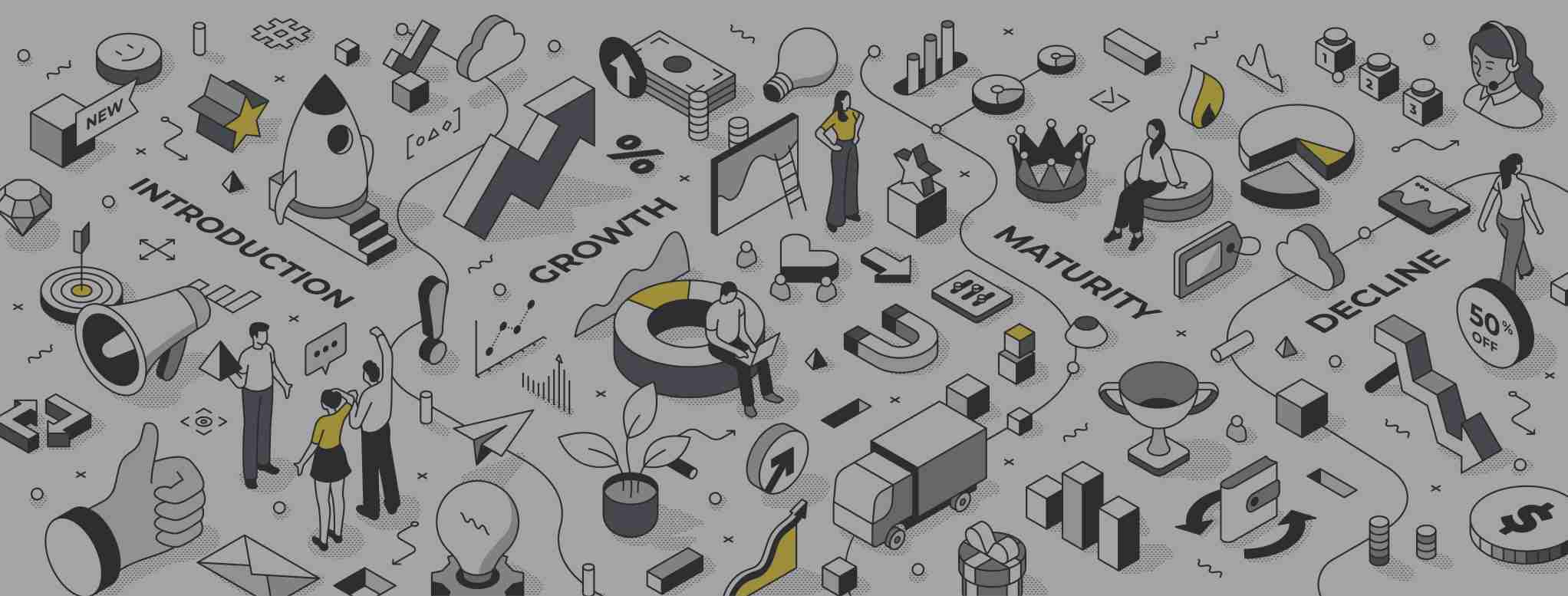Every business has to plan its go-to-market (GTM) strategy. It’s not a nice-to-have, it’s a need-to-have, and for those who decided to just get on with it, you’re probably picking apart a whole lot of trouble and trying to re-optimise your approach.
For product or service companies already struggling with their go-to-market plan, and those yet to formulate their approach, or launch a new product, this article contains a series of frameworks you can use to adjust your market GTM strategy.
Who is this article for?
This article is designed to help your CMO, CCO, COO or other leaders of your organisation to work SMART around product or service launches; that includes setting goals, devising pricing strategy and models, as well as capitalising on the use of a product launch checklist.
In addition to the aforementioned personas, sales reps should also take a look - you need to be aware of the company's go-to-market strategy as it affects how and what you can do or say.
By design, this article is targeted at supporting SaaS firms that are establishing their product marketing strategy, but whether you are a tech company or a service company, the principles can be applied in either scenario.
What is a go-to-market strategy?
Every SaaS platform is looking for product-market fit and understanding the target audience within the target market for their sales teams' ideal customer base. The go-to-market strategy should help your organisation understand:
- Customer pain points
- The buyer’s journey
- Which marketing channels do your potential customers operate in, especially social media, for lead generation
- How to align marketing and sales
- How to define the sales process
On top of establishing the information in the list above, you will also need to work on positioning (we wrote an article on that too).
But what goes into a great go-to-market strategy? Consider the following:
- SMART Goals
- Pricing Strategy
- Product or Service Tiers
- Go to Market Template
- Launch Checklist
To kick off your strategy, you have to work SMART. The next section looks into SMART goals and how they fit into the overall strategy. For those unfamiliar with the SMART acronym, it stands for
- Specific
- Measurable
- Achievable
- Realistic
- Time-Bound
What is a SMART template?
A SMART template is self-explanatory: it’s a template you can use to write down your business goals and what you need to do to achieve them. And as the graphic above shows, there are numerous questions to answer for each section. By answering these questions, you can define exactly what your goals are, why you want to achieve them, and how to get there.
How to be Specific in your planning
In the first pillar, we look at being Specific. The key to being specific is to answer the 5 W questions:
- Who is involved?
- What do I want to achieve?
- When do I want to achieve this?
- Where does my goal take place?
- Why is the goal important?
This framework for being specific is a key aspect of getting started. Below is an example of our 90-day planner. Work on the practice that a maximum of three advantageous goals can be achieved in a 90-day period. Trying to achieve any more than that in such a short time frame is simply unrealistic.
To start, set your first three goals across the top of the columns and the category fields down the side are where you list the area of impact. You can then list your to-do’s that align with each area and goal.
Example 1 (PMA)
As you can see in this example, the three main goals were to understand, assess and optimise the current systems and processes, domain and product, personal and team development and business growth and priorities.
By being strategic about your goals and prioritising the key areas of focus with a clear time frame, you can see how easy it would be to effect change and make progress. And by applying the logic to your product or service launch plan, you place your organisation in a very strong position for building success.
But this is not all you need to build clear SMART goals. To expand on how you bring this together neatly, you still need to break your goals into SMART objectives.
Example 2 (PMA)
Taking the systems and processes from the goal-setting worksheet in example 1, you can see above how you break down your goals into bite-sized chunks. By carefully planning each step of the way, you can hold yourself and your team accountable for effectively accomplishing your targets. And whilst the planning process can seem daunting or arduous, not planning will certainly ensure your failure in the long term or at least keep you fighting fires going forward.
Next up, we have to dive into your pricing strategy; whilst SMART goals will help you deliver your milestones toward your go-live date, your pricing will be paramount to your success.
How to build a pricing strategy
The first step to building a successful pricing strategy is to understand the different models available to you. There are six key strategies that you can adopt, and each is explained below.
Cost-plus pricing
This pricing strategy involves adding up your costs, adding percentage points to profit, and setting your prices from there.
Competitor-based pricing
Study your nearest competitors and base your prices on what they’re charging. This is often a useful approach for start-ups. If you’re unsure of your market value, see what your competitors are doing.
Value-based pricing
The process of looking out towards your customers. Although time-consuming, if you ask your user base what they expect from your products or services, then you can charge them based on their feedback. This can sharpen up your market value and make sure you’re appealing to your audience.
Market penetration pricing
Here, you’ll ignore the real costs of your product, with the aim of choosing a competitive price. This can help you to launch onto the market and appeal to your audience immediately.
Premium pricing
Takes the approach that higher subscription costs mean better quality. So you charge above the market value for your product, with the explanation that your product offers more to your audience than your competitors.
Skimming pricing
This is the opposite of the market penetration strategy. Here, you make your subscription price high. The belief behind this is that customer demand will decrease the longer your product is available. So, you can lower the subscription cost over time, which makes it increasingly competitive in the market.
Now that we have described the strategies available to your business, it’s time to decide which of them would work best for you. But don’t be forced into choosing a model and sticking with it. Always test ideas and talk to potential customers before making a final decision. A good exercise would be to write up all of the models for your business and then eliminate them one by one until you have the best-suited model.
Now that you have started your pricing strategy, you need to choose a suitable pricing model. In the next chapter, we will break down the pricing models your business can adopt.
Understanding Pricing Models
There are ten pricing models available for your business. We will break them down individually for you below and discuss how they are best used.
Flat-rate pricing
You provide one product, one set of features, and a set price. It’s the simplest model and a straightforward way to sell your goods.
-
- Advantages: It’s easier to sell this way. You can focus all your marketing and sales on selling one offer.
- Disadvantages: It’s not very flexible, so you often have only one shot at winning over customers. So, you’ll need to make that opening offer very tempting.
Usage-based pricing
Pay-as-you-go, essentially. The cost of your software is down to the amount a customer uses it. The more usage, the higher the bill.
-
- Advantages: It’s fair to use—price scales alongside the time spent on the software. This means a customer can judge their use of your software for the right monthly fee. The model also removes big upfront fees, while charging heavy-cost users the right amount for their extra usage.
- Disadvantages: It makes it harder to tell what customer costs will be. In turn, that makes it more difficult to predict your revenue.
Tiered pricing
Here you can offer packages featuring different features to cover different needs and budgets.
-
- Advantages: You’ll appeal to many buyer personas and maximise the revenue from each type. There’s also a great chance to upsell, as customers can easily move to a better package if they need to.
- Disadvantages: It can confuse some customers in the sales funnel, leaving them to drop out of the sale. Also, heavier-use customers can easily exceed their use on a top-tier package.
Per-seat pricing
Using this, a customer pays a fixed monthly price. If they add another user, then the price doubles. And third and it trebles. So, it’s very clear to customers what their money buys them.
-
- Advantages: It’s easy to understand and helps customers calculate the costs. In turn, your revenue scales alongside your customers’ continuous extra users. And that means you can easily predict your revenue.
- Disadvantages: This model does let customers cheat with a single login between multiple colleagues. And that means it’s easy for customers to churn at a low cost when they’re done with the software.
Per active user pricing
Advancing from per-seat pricing, this model encourages customers to sign up as many employees as possible. But the customer is only charged for active users at the end of a billing period.
-
- Advantages: Customers get a great deal and don’t waste any money. They’re also more inclined to roll out the software across the company, without any huge bills if it doesn’t work out for them.
- Disadvantages: For smaller businesses, the pricing model doesn’t work as well for you. It’s more effective with enterprise-level organisations.
Per feature pricing
You can use your software’s features as a pricing model. Here, you provide tiers with different features available. For example, the highest cost is for all of your core features. The lowest charge for fewer.
-
- Advantages: It’s a convincing way to get customers to upgrade, as they’re aware of what they’re missing out on. It also saves your business resources if fewer customers use intensive features.
- Disadvantages: It’s tricky to get this right, and you could easily get the balance of your packages wrong. You may also annoy paying customers by blocking them from key features.
Customisable pricing
Here, you let customers customise their basic service package, adding on features as and when they need them.
-
- Advantages: It proves popular with smaller businesses, so it can help your software gain popularity with SMEs. Flexibility is a proven way to encourage subscriptions.
- Disadvantages: Revenue is uncertain as customers only choose certain features. And you risk devaluing your product by only offering certain features, rather than your full service.
Freemium
You could provide your software in a limited form for free. Around that, you can offer paid packages for those who want to improve what your software offers.
-
- Advantages: Can promote a high sign-up rate as customers try out your software. So, you get your foot in the door and have the potential for word of mouth to make you a success story.
- Disadvantages: Obviously, that may all result in no revenue if customers don’t start paying. Churn rates can also be high. And you risk devaluing what your business offers.
Freemium with ads
You use the freemium model but rely on adverts to generate income. Then, when a customer signs up for your paid service, you can remove the ads.
-
- Advantages: Guarantees you’ll have an income source while you wait for your software to gain more paying customers.
- Disadvantages: You may annoy your customers with adverts, which could lead to high churn rates. As well as poor word of mouth.
Per storage user
A combination of tiered and usage-based, here customers pick from a number of storage tiers. The more they need, the more you’ll charge them.
-
- Advantages: You charge customers for exactly what they’re using, so you can maximise profits. You also ensure customers don’t overuse their quota with unlimited storage space.
- Disadvantages: There’s a risk of excluding customers who don’t fit into your storage tiers.
Having comprehensively covered the pricing models and strategies available and advised on setting SMART goals for your business, you should now be well-positioned to capitalise on the information.
Like many things in business, pricing strategies and combined models need testing before you can settle on a defined choice, but devising a pricing policy can narrow down your risk.
Set your pricing policy
To set your pricing policy, you must first understand what it is. The pricing policy is a price-fixing decision-making method for your products or services, a marketing strategy as part of the marketing mix.
Your policy will need a pricing structure. Before introducing the product or service into the market, you must decide how the price will be structured (using the abovementioned strategies). The pricing strategy should lead to buying incentives through a targeted setting of the sales price.
The policy also helps achieve corporate goals like securing the market share or maximising revenue.
Overall, the pricing policy should be the guideline that governs the pricing strategy and describes the internal and external factors that impact pricing delivery within the go-to-market strategy.
By combining these frameworks, your product or service organisation will be in the best position to achieve its goals and generate revenue through its go-to-market strategy.
Please visit our blog for more information and content on factors that will help your strategy work towards your success and survival. For help with your go-to-market strategy, please get in touch. Our ARISE methodology accelerates operational alignment and growth through a done-for-you GTM strategy that gets you to market in under 90 days - and includes the vital competitor analysis, positioning, messaging, value proposition and buyer journey creation you need to make an impact. Alternatively, check out our go-to-market workshop for SaaS and technology companies here.




